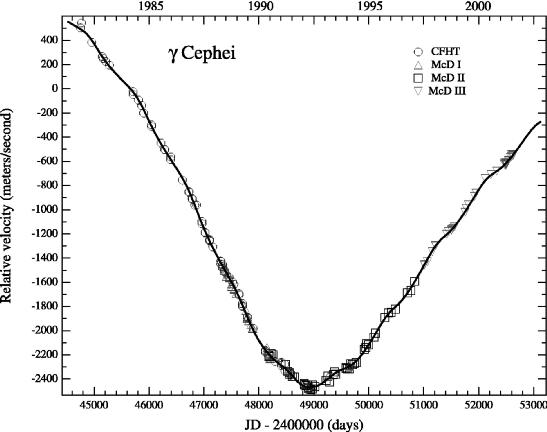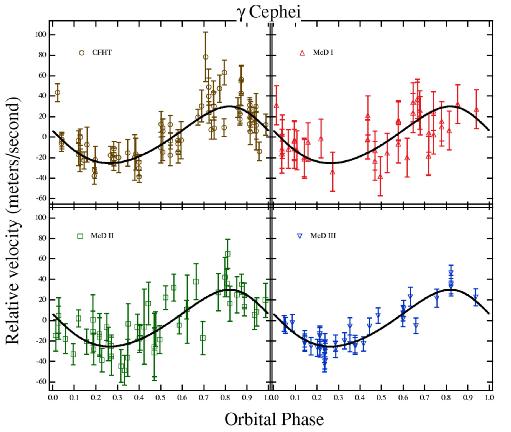A Planetary Companion to the Binary Star Gamma Cephei
Precise radial velocity measurements from McDonald Observatory establish the presence of a planet
orbiting the primary component of the gamma Cephei binary star system, as indicated by earlier data
from the CFHT (Walker et al. 1992). This companion is the first extrasolar planet in a relatively close
stellar binary system and thus has far-reaching implications for our understanding how planets form in
binary systems and for the overall frequency of planetary systems in our galaxy (since the majority of
stars exist in binary or multiple systems).

Radial velocity measurements of gamma Cephei showing a fraction of the binary orbit and
the superimposed variation due to the planet. The circles are the
CFHT data, while the remaining symbols show the McDonald 2.7m-telescope results.
The McDonald velocities
include 3 different data sets: 1.) the McD I:where telluric oxygen
lines were used as the wavelength standard, 2.) McD II: a
molecular iodine vapor (I2) absorption cell delivers the reference spectrum and 3.) McD III:
the cross-dispersed Coude spectrometer using the same I2 cell and the full spectral bandwidth.
Click for larger image
Gamma Cephei is a K1 sub-giant in a long-period (P> 50 yrs) binary system. Walker et al. (1992) first reported
short-term periodic radial velocity (RV) variations in the residuals after subtracting the velocity contribution due to
the stellar companion. These residual variations had a period of 2.52 yr period and were consistent with a Jupiter-mass
companion in orbit at approximately 2 AU from the primary. Walker et al. dismissed this hypothesis because they
detected weak variations in the Ca II emission line index with the same period as the planet.
Precise stellar radial velocity measurements for gamma Cep obtained with the Harlan J. Smith 2.7 m telescope at
McDonald Observatory now extend the time baseline of
observations to more than 20 years. The combined dataset shows that the planet period has been present and coherent
over the past 20 years. The long lived nature of the residual RV variations make it unlikely that they are due to
stellar rotation. Our Ca II S-index measurements show no periodic variations at the 2.5 yr period. Furthermore, no
appropriate period is found in (contemporaneous) Hipparcos photometry.
We conclude that a planet with a minimum mass of 1.7 Jupitermasses in orbit 2.13 AU from the primary star is the most
likely explanation for the short term RV variations in gamma Cep. This planet is in a binary star system with the
shortest binary period found so far and should provide an interesting case study for understanding how binary stars
influence the planet formation process.

The planetary signal after subtraction of the binary orbital motion and phased to the
orbital period of 2.5 years.
The planet can be seen in all four data sets (the circles are the CFHT data, while
the red, green and blue data points are the McDonald 2.7m-telescope results). The most
recent data (McD III, blue data set) have an rms-scatter of 8.2 m/s around
the planet's orbit.
Click for larger image
Parameters of the planet and its orbit:
Period = 905.57 ± 3.08 [days]
T periastron = 253121.925 ± 66.9 [JD]
e = 0.12 ± 0.05
omega = 49.6 ± 25.6 [deg]
K = 27.5 ± 1.5 [m/s]
M sin i = 1.7 ± 0.4 [Jupiter]
a = 2.13 ± 0.05 [AU]
Parameters of the binary orbit:
Period = 20750.7 ± 1568.6 [days]
T periastron = 248429.03 ± 27.0 [JD]
e = 0.361 ± 0.023
omega = 158.8 ± 1.2 [deg]
K = 1.82 ± 0.049 [km/s]
f(m) = 0.0106 ± 0.0012 M [Sun]
a = 18.5 ± 1.1 [AU]
Properties of the host star: (derived by Klaus Fuhrmann)
Spectral type = K1 IV
V = 3.22 [mag]
M bol = 2.14 [mag]
d = 13.79 [parsec] (based on Hipparcos parallax)
M = 1.59 ± 0.12 M [Sun]
Teff = 4888 [K]
log g = 3.33
Radius = 4.66 [R Sun]
References:
Hatzes A.P., Cochran W.D., Endl M., McArthur B., Paulson D.B., Walker, G.A.H., Campbell, B., Stephenson Y. 2003, ApJ, 599, 1383
paper (pdf-file)
Walker, G.A.H., Bohlender, D.A., Walker, A.R., Irwin, A.W., Stephenson, L.S., Larson, A.,
1992, ApJ, 396, L91-94
link to ADS service
Press Release:
McDonald Observatory press release (9th.Oct.2002)
Back to Planetary Systems
webpage by: Michael Endl

